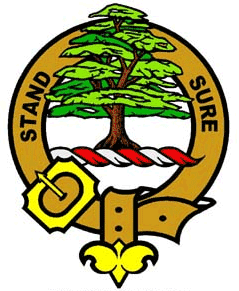Anderson Clan
Anderson Crest: An Oak tree Proper.
Anderson Clan Motto: Stand Sure.
Anderson Clan History: The surname Anderson along with MacAndrew (son of Andrew) and Gillanders (servant of St Andrew) is common throughout Scotland particularly in the Lowlands and the North East. The Highland form MacAndrew is thought to be connected with the Clan Anrias, a sept of Clan Ross who were also associated with the Clan Chattan. It is therefore difficult to establish a common ancestor. The earliest mention of the name appears to be in the thirteen century where, in 1296, David le fiz Andreu, burgess of Peebles and Duncan fiz Andreu of Dumfries took an oath of fealty along with many others, often reluctantly, to Edward I of England during the Wars of Independence.
Through the sixteenth and seventeenth centauries several burghs were represented by Andersons. The famous Foreman-Workman heraldic manuscript (1566) depicts arms for Anderson of that Ilk, suggesting that there was a representer of the Clan. Around the same time there was recorded an Officer of Arms, Carrick Pursuivant, called James Anderson of Sterheuch and this office is still used in the Court of the Lord Lyon. It is possible that this James Anderson was the Representer and Carrick Pursuivant were the same person but this has not been substantiated.
The Andersons of Noth, Strathbogie, were a powerful and influential family and held Westerton until it was eventually sold to the neighbouring Duffs of Drummuir Estate in the late 1800's. They claim James Anderson as their progenitor. Their Crest of an oak tree has been nominally accepted as the Clan Crest Badge together with their Motto, "Stand Sure". Their Cadets are Anderson of Westerton, (Wester-) Ardbrake and Gracedieu; Anderson of Kinneddar; and Anderson of Newbiggin and Kingask. Other prominent lines were: Anderson of Dowhill; Anderson of Stobcross; Anderson of Inchyra and St Germain; Anderson of Linkwood; Anderson of Bourtie; Seton-Anderson of Mounie; and Anderson of Candacraig.
Patrick Anderson, the first Laird of Candacraig lived in the early 1500's. In 1834, at the height of the highland clearances, the family left to seek their fortunes in Quebec Canada. In 1847 the 11th Laird Robert Anderson died and his nephew, Alexander Anderson of huntingdon, returned to take up the title. He sold the estate in 1866 and returned to Canada.
Places of Interest: Bourtie House, nr. Inverurie, Aberdeenshire. Private mansion house constructed in the mid-1700's by Patrick Anderson and Elizabeth Ogilvy. The house sits on the site of a much earlier property, held by the Andersons in previous centuries. Candacraig House, Strathdon, Aberdeenshire. Owned by the Andersons from the early 1600's until the mid-1800's. Former residence of Billy Connolly, Scottish comedian and actor. The estate is now available for private and corporate events. Mounie Castle, Daviot, Aberdeenshire. This 17th-century castle was home to the Anderson-Seton family in the 1800's.
Surname distribution in Scotland: The Anderson name is most commonly found in Aberdeen City, Aberdeenshire (includes historic county of Kincardineshire and part of Banffshire), Moray, Shetland, Angus (Forfarshire), Dundee City and the Scottish Borders (formed from Berwickshire, Peeblesshire, Roxburghshire, Selkirkshire and part of Midlothian).
Buy a Clan Anderson certificate.

